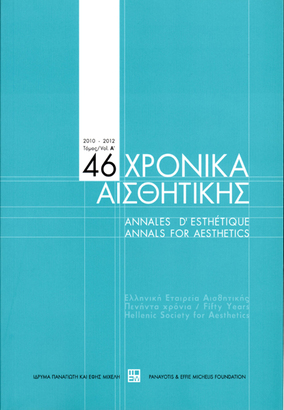Το γραφικό ως αισθητική ποιότητα, η αισθητική του περιβάλλοντος και το ελληνικό τοπίο
Part of : Χρονικά αισθητικής : ετήσιον δελτίον της Ελληνικής Εταιρείας Αισθητικής ; Vol.41, No.Β, 2001, pages 477-495
Issue:
Pages:
477-495
Parallel Title:
The picturesque as an aesthetic quality, the aesthetics of environment and the greek landscape
Section Title:
Ανακοινώσεις/papers/articles
Author:
Abstract:
In this paper, my aim is to examine the picturesque as a concept, an aesthetic quality and an aesthetic category - in relation to its conceptual meaning in the history of ideas of eighteenth century British aesthetics and its usage throughout the nineteenth century in an attempt to evaluate it as an ontological and phenomenological quality of Greek landscape and to associate it with contemporary environmental aesthetics.The term picturesque is used indiscriminately to denote either a particular style of painting or areas of the natural environment that possess characteristics that we particularly admire. The picturesque was originally associated with the rules of “correct painting”, or with what the ancient Greeks referred to as graphik\ it refers, therefore, to the very essence of painting. This term secondarily refers to any object that fascinates, attracts and stimulates the eye and the mind of the spectator when offered as a subject of representation according to the example of the paintings of Claude Lorraine and Gaspard Poussin (Dughet) and of other painters of the Mediterranean landscape. Furthermore, the picturesque refers to anything worthy of being painted due to its characteristic structure and appearance. Nonetheless, even though the term picturesque does not have a clear descriptive content and does not revoke a specific imagery, it was incorporated during the eighteenth century in aesthetic vocabulary, and gradually acquired an ambiguous meaning synonym either to beauty and sublimity or to the enchanting, the colorful and the vivid, eventually becoming equivalent to anything aesthetically suited to pictorial representation.The study of the conceptual changes and the usages of the concept of picturesque denotes the alterations in preferences and taste throughout the eighteenth century; this shift is analysed by the British aestheticians W. Giplin, Uvedale Price and Richard Payne Knight who attributed to it the meanings of “vivid, enchanting, colourful, and impressive in non-dramatic manner”. Furthermore, in the nineteenth century, the word picturesque was related to the romantic, and was established as a descriptive term of the aesthetic potentialities on the natural landscape. Also, the term picturesque, in its general meaning or in combination with other aesthetic qualities, such as beautiful or sublime, was widely used in travel books, frequently referring to the Greek landscape. Romantic writers and artists depict the Greek landscape as beautiful, majestic, sublime and picturesque - terms that are still used in its description nowadays.Taking into consideration the significance of the picturesque in the formulation of eighteenth and nineteenth century aesthetic theories, and the contemporary concern of environmental aesthetics for the preservation and amelioration of the environment, this paper points out that modern aestheticians resort to the aesthetic theories of the past in an attempt to establish principles that will help constitute a humanitarian environment. Since in contemporary aesthetic theory the picturesque is still one of the dominant aesthetic and cultural categories, it is necessary to render the authorities and the public sensitive to the Greek landscape which is distinguished for its picturesqueness, and to try to preserve it by all possible means.
Subject:
Keywords:
ζωγραφική, τοπία, φύση, Ελλάς
Notes:
Περιέχει εικόνες




